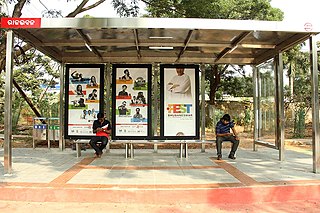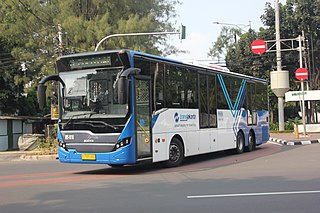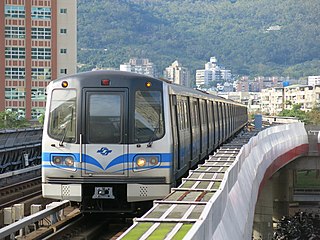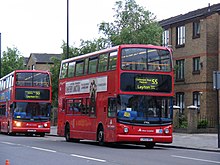
Personal Rapid Transit (PRT), also referred to as podcars or guided/railed taxis, is a public transport mode featuring small low-capacity automated vehicles operating on a network of specially built guideways. PRT is a type of automated guideway transit (AGT), a class of system which also includes larger vehicles all the way to small subway systems. In terms of routing, it tends towards personal public transport systems.

A bus stop is a place where buses stop for passengers to get on and off the bus. The construction of bus stops tends to reflect the level of usage, where stops at busy locations may have shelters, seating, and possibly electronic passenger information systems; less busy stops may use a simple pole and flag to mark the location. Bus stops are, in some locations, clustered together into transport hubs allowing interchange between routes from nearby stops and with other public transport modes to maximise convenience.

Bus rapid transit (BRT), also referred to as a busway or transitway, is a bus-based public transport system designed to have much more capacity, reliability and other quality features than a conventional bus system. Typically, a BRT system includes roadways that are dedicated to buses, and gives priority to buses at intersections where buses may interact with other traffic; alongside design features to reduce delays caused by passengers boarding or leaving buses, or paying fares. BRT aims to combine the capacity and speed of a light rail transit (LRT) or mass rapid transit (MRT) system with the flexibility, lower cost and simplicity of a bus system.

The L Taraval is a hybrid light rail/streetcar line of the Muni Metro system in San Francisco, California, mainly serving the Parkside District. Since 2021, the line has been suspended and replaced by buses until the end of 2024 for an improvement project along Taraval Street.
Skip-stop is a public transit service pattern which reduces travel times and increases capacity by having vehicles skip certain stops along a route. Originating in rapid transit systems, skip-stop may be also used in light rail and bus systems.
Cabinentaxi, sometimes Cabintaxi in English, was a German people mover development project undertaken by Demag and Messerschmitt-Bölkow-Blohm with funding and support from the Bundesministerium für Forschung und Technologie. Cabinentaxi was designed to offer low-cost mass transit services where conventional systems, like a metro, would be too expensive to deploy due to low ridership or high capital costs.

In public transport, a request stop, flag stop, or whistle stop is a stop or station at which buses or trains, respectively, stop only on request; that is, only if there are passengers or freight to be picked up or dropped off. In this way, stops with low passenger counts can be incorporated into a route without introducing unnecessary delay. Vehicles may also save fuel by continuing through a station when there is no need to stop.

TheLehigh and Northampton Transportation Authority (LANTa) is a regional public transportation authority that provides public bus and rapid transit service throughout the Lehigh Valley region of eastern Pennsylvania, including Allentown, Bethlehem, Easton, and their respective suburbs. LANTa is the third-largest public transit agency in Pennsylvania, behind Pittsburgh Regional Transit and SEPTA, with an annual ridership of 3,392,200 as of fiscal year 2023.
Headway is the distance or duration between vehicles in a transit system measured in space or time. The minimum headway is the shortest such distance or time achievable by a system without a reduction in the speed of vehicles. The precise definition varies depending on the application, but it is most commonly measured as the distance from the tip of one vehicle to the tip of the next one behind it. It can be expressed as the distance between vehicles, or as time it will take for the trailing vehicle to cover that distance. A "shorter" headway signifies closer spacing between the vehicles. Airplanes operate with headways measured in hours or days, freight trains and commuter rail systems might have headways measured in parts of an hour, metro and light rail systems operate with headways on the order of 90 seconds to 20 minutes, and vehicles on a freeway can have as little as 2 seconds headway between them.

A queue jump is a type of roadway geometry used to provide preference to buses at intersections, often found in bus rapid transit systems. It consists of an additional travel lane on the approach to a signalised intersection. This lane is often restricted to transit vehicles only. A queue jump lane is usually accompanied by a signal which provides a phase specifically for vehicles within the queue jump. Vehicles in the queue jump lane get a "head-start" over other queued vehicles and can therefore merge into the regular travel lanes immediately beyond the signal. The intent of the lane is to allow the higher-capacity vehicles to cut to the front of the queue, reducing the delay caused by the signal and improving the operational efficiency of the transit system.

In scheduled transportation, a layover is a point where a vehicle stops, with passengers possibly changing vehicles. In public transit, this typically takes a few minutes at a trip terminal. For air travel, where layovers are longer, passengers will exit the vehicle and wait in the terminal, often to board another vehicle traveling elsewhere.
In public transportation, schedule adherence or on-time performance refers to the level of success of the service remaining on the published schedule. On time performance, sometimes referred to as on time running, is normally expressed as a percentage, with a higher percentage meaning more vehicles are on time. The level of on time performance for many transport systems is a very important measure of the effectiveness of the system.

Public transport bus services are generally based on regular operation of transit buses along a route calling at agreed bus stops according to a published public transport timetable. The state of Tamil Nadu in India operates the world's largest bus corporation called as TNSTC which is fully owned by Government of Tamil nadu, with a fleet of 20,258 buses and a daily ridership of 17 million.

RapidRide is a network of limited-stop bus routes with some bus rapid transit features in King County, Washington, operated by King County Metro. The network consists of seven routes totaling 76 miles (122 km) that carried riders on approximately 64,860 trips on an average weekday in 2016, comprising about 17 percent of King County Metro's total daily ridership.

In transportation, dwell time or terminal dwell time refers to the time a vehicle such as a public transit bus or train spends at a scheduled stop without moving. Typically, this time is spent boarding or deboarding passengers, but it may also be spent waiting for traffic ahead to clear, trying to merge into parallel traffic, or idling time in order to get back on schedule. Dwell time is one common measure of efficiency in public transport, with shorter dwell times being universally desirable.
A vehicle tracking system combines the use of automatic vehicle location in individual vehicles with software that collects these fleet data for a comprehensive picture of vehicle locations. Modern vehicle tracking systems commonly use GPS or GLONASS technology for locating the vehicle, but other types of automatic vehicle location technology can also be used. Vehicle information can be viewed on electronic maps via the Internet or specialized software. Urban public transit authorities are an increasingly common user of vehicle tracking systems, particularly in large cities.

Public transport is a system of transport for passengers by group travel systems available for use by the general public unlike private transport, typically managed on a schedule, operated on established routes, and that charge a posted fee for each trip. There is no rigid definition of which kinds of transport are included, and air travel is often not thought of when discussing public transport—dictionaries use wording like "buses, trains, etc." Examples of public transport include city buses, trolleybuses, trams and passenger trains, rapid transit and ferries. Public transport between cities is dominated by airlines, coaches, and intercity rail. High-speed rail networks are being developed in many parts of the world.

A clock-face schedule, also cyclic schedule, is a timetable system under which public transport services run at consistent intervals, as opposed to a timetable that is purely driven by demand and has irregular headways. The name derives from the fact that departures take place at the same time or times during the day. For example, services with a half-hourly frequency might leave at 5:15, 5:45, 6:15, 6:45, 7:15, 7:45 etc.
Minitram was an automated guideway transit system studied by the Transport and Road Research Laboratory (TRRL), part of the UK Department of the Environment's Ministry of Transport. The system was based on small, completely automated tram-like vehicles of about 25 passengers that could be connected together into three-car trains to increase capacity. Proposed designs were submitted by Hawker Siddeley Dynamics (HSD) and EASAMS. HSD's system used rubber wheels and EASAMS' steerable steel ones, but the projects were otherwise similar and notably shared a linear motor for propulsion and most braking. A series of failed sales efforts in the UK and to the GO-Urban system in Toronto, combined with decreased government spending in the 1970s, led to the concept being abandoned.

A crush load is a level of passenger loading in a transport vehicle which is so high that passengers are "crushed" against one another. It represents an extreme form of passenger loading, and normally considered to be representative of a system with serious capacity limitations. Crush loads result from too many passengers within a vehicle designed for a much smaller number. Crush loaded trains or buses are so heavily loaded that for most passengers physical contact with several other nearby passengers is impossible to avoid.














